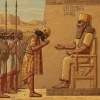
Encyclopedia Britannica
About Crucifixion
"Crucifixion: important method of capital punishment,
particularly among the Persians, Seleucids, Jews,
Carthaginians, and Romans from about the 6th century BC to
the 4th century AD. Constantine the Great, the first
Christian emperor, abolished it in the Roman Empire in AD
337, out of veneration for Jesus Christ, the most famous
victim of crucifixion. Punishment: There were various
methods of performing the execution. Usually, the condemned
man, after being whipped, or "scourged," dragged the
crossbeam of his cross to the place of punishment, where the
upright shaft was already fixed in the ground. Stripped of
his clothing either then or earlier at his scourging, he was
bound fast with outstretched arms to the crossbeam or nailed
firmly to it through the wrists. The crossbeam was then
raised high against the upright shaft and made fast to it
about 9 to 12 feet (approximately 3 metres) from the ground.
Next, the feet were tightly bound or nailed to the upright
shaft. A ledge inserted about halfway up the upright shaft
gave some support to the body; evidence for a similar ledge
for the feet is rare and late. Over the criminal's head was
placed a notice stating his name and his crime. Death,
apparently caused by exhaustion or by heart failure, could
be hastened by shattering the legs (crurifragium) with an
iron club, so that shock and asphyxiation soon ended his
life. Crucifixion was most frequently used to punish
political or religious agitators, pirates, slaves, or those
who had no civil rights. In 519 BC Darius I, king of Persia,
crucified 3,000 political opponents in Babylon; in 88 BC
Alexander Jannaeus, the Judaean king and high priest,
crucified 800 Pharisaic opponents; and in about AD 32
Pontius Pilate had Jesus of Nazareth put to death by
crucifixion.
The account of Jesus Christ's Crucifixion in the Gospels
begins with his scourging. The Roman soldiers then mocked
him as the "King of the Jews" by clothing him in a purple
robe and a crown of thorns and led him slowly to Mount
Calvary, or Golgotha; one Simon of Cyrene was allowed to aid
him in carrying the cross. At the place of execution he was
stripped and then nailed to the cross, at least nailed by
his hands; and above him at the top of the cross was placed
the condemnatory inscription stating his crime of professing
to be King of the Jews. (The Gospels differ slightly in the
wording but agree that the inscription was in "Hebrew," or
Aramaic, as well as Latin and Greek.) On the cross Jesus
hung for three hours of agony. The soldiers divided his
garments and cast lots for his seamless robe; various
onlookers taunted him. Crucified on either side of Jesus
were two convicted thieves, whom the soldiers dispatched at
eventide by breaking their legs. The soldiers found Jesus
already dead; but, to be certain, one of them drove a spear
into his side, from which poured blood and water. He was
taken down before sunset (in deference to Jewish custom) and
buried in a rock-hewn tomb."
Read The Bible
- 1599 Geneva Bible (GNV)
- 21st Century King James Version (KJ21)
- American Standard Version (ASV)
- Amplified Bible (AMP)
- Amplified Bible, Classic Edition (AMPC)
- Authorized (King James) Version (AKJV)
- BRG Bible (BRG)
- Christian Standard Bible (CSB)
- Common English Bible (CEB)
- Complete Jewish Bible (CJB)
- Contemporary English Version (CEV)
- Darby Translation (DARBY)
- Disciples’ Literal New Testament (DLNT)
- Douay-Rheims 1899 American Edition (DRA)
- Easy-to-Read Version (ERV)
- English Standard Version (ESV)
- English Standard Version Anglicised (ESVUK)
- Evangelical Heritage Version (EHV)
- Expanded Bible (EXB)
- GOD’S WORD Translation (GW)
- Good News Translation (GNT)
- Holman Christian Standard Bible (HCSB)
- International Children’s Bible (ICB)
- International Standard Version (ISV)
- J.B. Phillips New Testament (PHILLIPS)
- Jubilee Bible 2000 (JUB)
- King James Version (KJV)
- Lexham English Bible (LEB)
- Living Bible (TLB)
- Modern English Version (MEV)
- Mounce Reverse Interlinear New Testament (MOUNCE)
- Names of God Bible (NOG)
- New American Bible (Revised Edition) (NABRE)
- New American Standard Bible (NASB)
- New American Standard Bible 1995 (NASB1995)
- New Catholic Bible (NCB)
- New Century Version (NCV)
- New English Translation (NET)
- New International Reader's Version (NIRV)
- New International Version - UK (NIVUK)
- New International Version (NIV)
- New King James Version (NKJV)
- New Life Version (NLV)
- New Living Translation (NLT)
- New Matthew Bible (NMB)
- New Revised Standard Version (NRSV)
- New Revised Standard Version Catholic Edition (NRSVCE)
- New Revised Standard Version, Anglicised (NRSVA)
- New Revised Standard Version, Anglicised Catholic Edition (NRSVACE)
- New Testament for Everyone (NTE)
- Orthodox Jewish Bible (OJB)
- Revised Geneva Translation (RGT)
- Revised Standard Version (RSV)
- Revised Standard Version Catholic Edition (RSVCE)
- The Message (MSG)
- The Voice (VOICE)
- Tree of Life Version (TLV)
- World English Bible (WEB)
- Worldwide English (New Testament) (WE)
- Wycliffe Bible (WYC)
- Young's Literal Translation (YLT)
Table of Contents
Main Menu
- Ancient Assyrian Social Structure
- Ancient Babylonia
- Ancient Canaan During the Time of Joshua
- Ancient History Timeline
- Ancient Oil Lamps
- Antonia Fortress
- Archaeology of Ancient Assyria
- Assyria and Bible Prophecy
- Augustus Caesar
- Background Bible Study
- Bible
- Biblical Geography
- Fallen Empires - Archaeological Discoveries and the Bible
- First Century Jerusalem
- Glossary of Latin Words
- Herod Agrippa I
- Herod Antipas
- Herod the Great
- Herod's Temple
- High Priest's in New Testament Times
- Jewish Literature in New Testament Times
- Library collection
- Map of David's Kingdom
- Map of the Divided Kingdom - Israel and Judah
- Map of the Ministry of Jesus
- Matthew Henry Bible Commentary
- Messianic Prophecy
- Nero Caesar Emperor
- Online Bible Maps
- Paul's First Missionary Journey
- Paul's Second Missionary Journey
- Paul's Third Missionary Journey
- Pontius Pilate
- Questions About the Ancient World
- Tabernacle of Ancient Israel
- Tax Collectors in New Testament Times
- The Babylonian Captivity
- The Black Obelisk of Shalmaneser
- The Books of the New Testament
- The Court of the Gentiles
- The Court of the Women in the Temple
- The Destruction of Israel
- The Fall of Judah with Map
- The History Of Rome
- The Incredible Bible
- The Jewish Calendar in Ancient Hebrew History
- The Life of Jesus in Chronological Order
- The Life of Jesus in Harmony
- The Names of God
- The New Testament
- The Old Testament
- The Passion of the Christ
- The Pharisees
- The Sacred Year of Israel in New Testament Times
- The Samaritans
- The Scribes
Ancient Questions
- Why Do the Huldah Gates Appear Different in Ancient Replicas and Modern Photos?
- What Is the Origin of the Japanese and Chinese Peoples? A Biblical Perspective
- How did the ancient Greeks and Romans practice medicine and treat illnesses?
- What were the major contributions of ancient Babylon to mathematics and astronomy?
- How did the ancient Persians create and administer their vast empire?
- What were the cultural and artistic achievements of ancient India, particularly during the Gupta Empire?
- How did ancient civilizations like the Incas and Aztecs build their remarkable cities and structures?
- What were the major trade routes and trading practices of the ancient world?
- What was the role of slavery in ancient societies like Rome and Greece?
- How did the ancient Mayans develop their sophisticated calendar system?
Bible Study Questions
- Why Do Christians Celebrate Christmas?
- How Many Chapters Are There in the Bible?
- The Five Key Visions in the New Testament
- The 400-Year Prophecy: Unpacking Genesis 15 and the Journey of a People
- The Authorized (King James) Version (AKJV): Historical Significance, Translation Methodology, and Lasting Impact
- Exploring the English Standard Version (ESV): Its Aspects, Comparisons, Impact on Biblical Studies, and Church Use
- A Detailed Historical Analysis of Language Updates in the KJ21: Comparison with Other Versions
- A Detailed Historical Analysis of the American Standard Version (ASV): Comparison to the King James Version, Influence on Later Translations, and Evaluation of Strengths and Weaknesses
- A Detailed Historical Analysis of Amplifications in the Amplified Bible (AMP) and Its Comparison to Other Bible Translations
- Detailed Historical Analysis of the Amplified Bible Classic Edition (AMPC): Examples of Amplifications and Comparative Analysis with Other Bible Translations
About
Welcome to Free Bible: Unearthing the Past, Illuminating the Present! Step into a world where ancient history and biblical narratives intertwine, inviting you to explore the rich tapestry of human civilization.
Discover the captivating stories of forgotten empires, delve into the customs and cultures of our ancestors, and witness the remarkable findings unearthed by dedicated archaeologists.
Immerse yourself in a treasure trove of knowledge, where the past comes alive and illuminates our understanding of the present.
Join us on this extraordinary journey through time, where curiosity is rewarded and ancient mysteries await your exploration.
Recent posts
-

How to Wear a Cross Pendant as a Daily Reminder of Your Faith
Picture this: each morning, you grab a little piece of metal—cool to the touch—and slide it around your neck. It’s a cross pendant, nothing fanc... -

The Grimanis: A Family Dedicated to Public Health and Philanthropy
In the serene outskirts of London, the Grimani family stands as a beacon of dedication to public health and social responsibility. Led by Dr. John Leo... -

Jehu Bows Before Shalmaneser III: A Unique Depiction in Ancient Near Eastern Art
One of the most fascinating and historically significant reliefs from the ancient Near East is the depiction of Jehu, king of Israel, bowing before th... -

A Joyful Tradition: The History of the Jubilee in the Catholic Church
Every so often, the Catholic Church invites the faithful to celebrate a special time of grace and renewal known as a Jubilee. This long-standing tradi... -

Healthlion Medical Solutions and LionHeart Family Institute Publish Comprehensive Study on Physician-Owned Family Practices in the U.S.
Healthlion Medical Solutions and the LionHeart Family Institute have officially concluded their extensive 12-month research on the future of physician...